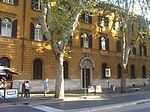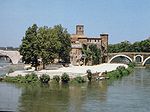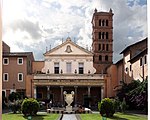Sant'Agata in Trastevere
18th-century Roman Catholic church buildings in Italy9th-century churches in ItalyBaroque architecture in RomeRoman Catholic churches completed in 1711Roman Catholic churches in Rome

Sant'Agata in Trastevere is one of the churches of Rome, located in the Trastevere district, at Largo San Giovanni de Matha, 91. The church is dedicated to the Sicilian St Agatha, martyred in approximately 251, whose cult soon spread well beyond Sicily. She is one of several virgin martyrs who are commemorated by name in the Canon of the Mass. Agatha is also depicted in the famous mosaics of the church of Sant'Apollinare Nuovo in Ravenna, where she appears, richly dressed, in the procession of women martyrs along the north wall.
Excerpt from the Wikipedia article Sant'Agata in Trastevere (License: CC BY-SA 3.0, Authors, Images).Sant'Agata in Trastevere
Largo San Giovanni De Matha, Rome Municipio Roma I
Geographical coordinates (GPS) Address External links Nearby Places Show on map
Geographical coordinates (GPS)
| Latitude | Longitude |
|---|---|
| N 41.88953 ° | E 12.47361 ° |
Address
Sant’Agata in Trastevere
Largo San Giovanni De Matha
00153 Rome, Municipio Roma I
Lazio, Italy
Open on Google Maps











